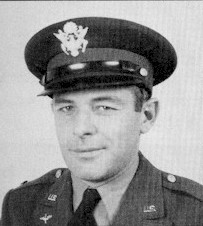
An aircraft is a vehicle that is able to fly by gaining support from the air. It counters the force of gravity by using either static lift or the dynamic lift of an airfoil, or, in a few cases, direct downward thrust from its engines. Common examples of aircraft include airplanes, helicopters, airships, gliders, paramotors, and hot air balloons.

Aerial refueling, also referred to as air refueling, in-flight refueling (IFR), air-to-air refueling (AAR), and tanking, is the process of transferring aviation fuel from one aircraft to another while both aircraft are in flight. The two main refueling systems are probe-and-drogue, which is simpler to adapt to existing aircraft, and the flying boom, which offers faster fuel transfer, but requires a dedicated boom operator station.
This is a list of aviation-related events from 1935:

John Rodgers was an officer in the United States Navy and a pioneering aviator.

Robert Anderson Hoover was an American fighter pilot, test pilot, flight instructor, and record-setting air show aviator.

Al Key was an American aviator who broke a flight endurance record with his brother Fred in 1935.

An airplane or aeroplane, informally plane, is a fixed-wing aircraft that is propelled forward by thrust from a jet engine, propeller, or rocket engine. Airplanes come in a variety of sizes, shapes, and wing configurations. The broad spectrum of uses for airplanes includes recreation, transportation of goods and people, military, and research. Worldwide, commercial aviation transports more than four billion passengers annually on airliners and transports more than 200 billion tonne-kilometers of cargo annually, which is less than 1% of the world's cargo movement. Most airplanes are flown by a pilot on board the aircraft, but some are designed to be remotely or computer-controlled such as drones.
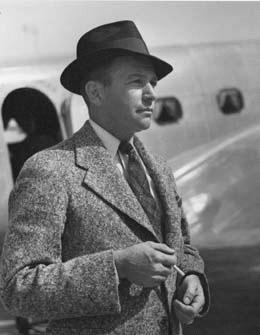
Clyde Edward Pangborn, nicknamed "Upside-Down Pangborn", was an American aviator and barnstormer who performed aerial stunts in the 1920s for the Gates Flying Circus. He was its half-owner, chief pilot and operating manager, working in partnership with Ivan R. Gates. In 1931, Pangborn and co-pilot Hugh Herndon Jr. flew their plane, Miss Veedol, on the first non-stop flight across the Pacific Ocean.

Bangor International Airport is a joint civil-military public airport on the west side of the city of Bangor, in Penobscot County, Maine, United States. Owned and operated by the City of Bangor, the airport has a single runway measuring 11,440 by 200 ft. Formerly a military installation known as Dow Air Force Base, Bangor International Airport remains home to the 101st Air Refueling Wing of the Maine Air National Guard, although most of the Air Force's aircraft and personnel left in the late 1960s. BGR covers 2,079 acres of land. It is included in the Federal Aviation Administration (FAA) National Plan of Integrated Airport Systems for 2023–2027 categorized it as a non-hub primary commercial service facility.

Meridian Regional Airport is a joint civil-military public use airport located at Key Field, a joint-use public/military airfield. It is located 3 nautical miles southwest of Meridian, a city in Lauderdale County, Mississippi, United States. The Meridian Airport Authority owns the airport. At 10,003 feet (3,049 m), Key Field is home to the longest public use runway in Mississippi. It is mostly used for general aviation and military traffic, but it is also served by one commercial airline with scheduled passenger service subsidized by the Essential Air Service program.
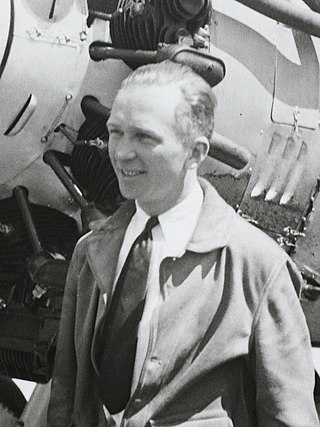
Clarence Duncan Chamberlin was an American pioneer of aviation, being the second man to pilot a fixed-wing aircraft across the Atlantic Ocean, from New York to the European mainland, while carrying the first transatlantic passenger.

Lowell Herbert Smith was a pioneer American airman who piloted the first airplane to receive a complete mid-air refueling on June 27, 1923, and later set an endurance record of 37 hours on August 28, both in a De Havilland DH-4B. Smith also piloted the Douglas World Cruiser Chicago, which along with one other made the first aerial circumnavigation in 1924. Smith held 16 records for military aircraft in speed, endurance and distance. He was awarded the best achievement in flight Mackay Trophy twice.

Question Mark ("?") was a modified Atlantic-Fokker C-2A transport airplane of the United States Army Air Corps. In 1929, commanded by Major Carl A. Spaatz, it was flown for a flight endurance record as part of an experiment with aerial refueling. Question Mark established new world records in aviation for sustained flight (heavier-than-air), refueled flight, sustained flight (lighter-than-air), and distance between January 1 and January 7, 1929, in a nonstop flight of 151 hours near Los Angeles, California.

The 186th Air Refueling Wing is a unit of the Mississippi Air National Guard stationed at Meridian Regional Airport, Mississippi. The 153d Air Refueling Squadron, assigned to the Wing's 186th Operations Group, was established on 18 August 1939 as the 153d Observation Squadron, one of the 29 National Guard observation squadrons formed before World War II.

The Mississippi Air National Guard, commonly known as the Mississippi Air Guard, is the aerial militia of the State of Mississippi, United States of America. It is, along with the Mississippi Army National Guard, an element of the Mississippi National Guard.

The 153d Air Refueling Squadron is a unit of the Mississippi Air National Guard 186th Air Refueling Wing located at Key Field Air National Guard Base, Mississippi. The 153d is equipped with the KC-135 Stratotanker aircraft.

The Wright R-540 Whirlwind was a series of five-cylinder air-cooled radial aircraft engines built by the Wright Aeronautical division of Curtiss-Wright. These engines had a displacement of 540 in³ (8.85 L) and power ratings of around 165-175 hp (123-130 kW). They were the smallest members of the Wright Whirlwind engine family.
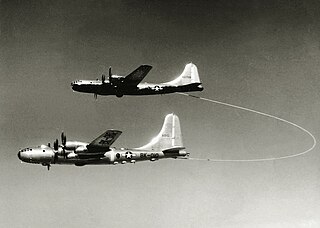
Lucky Lady II is a United States Air Force Boeing B-50 Superfortress that became the first airplane to circle the world nonstop. Its 1949 journey, assisted by in-flight refueling, lasted 94 hours and 1 minute.
Viola Estelle Gentry was an American aviator, best known for setting the first non-refueling endurance record for women.
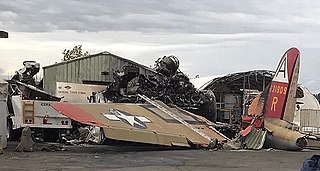
On October 2, 2019, a Boeing B-17 Flying Fortress owned by the Collings Foundation crashed at Bradley International Airport, Windsor Locks, Connecticut, United States. Seven of the thirteen people on board were killed, and the other six, as well as one person on the ground, were injured. The aircraft was destroyed by fire, with only the tail and a portion of one wing remaining.

